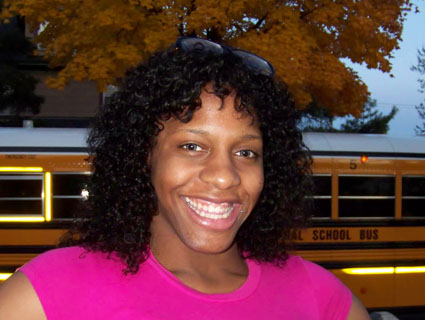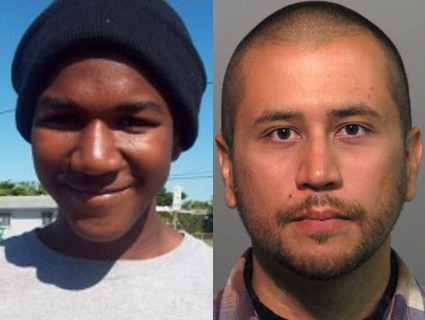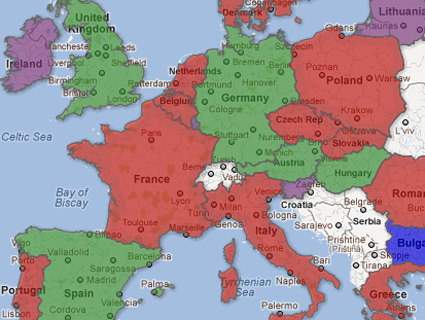
CeCe McDonaldPhoto by Billy Navarro Jr.
Update: On June 4, CeCe McDonald was sentenced to 41 months in prison. This is the minimum sentence for second degree manslaughter in Minnesota. CeCe will receive credit for the 275 days she’s already spent in custody. Along with a reduction in time served for presumed good behavior, McDonald will likely be released from prison in under two years.
Because she is transgender, it’s expected that McDonald will be sent to Minnesota Correctional Facility-St. Cloud, a men’s prison. According to the Minneapolis Star-Tribune, once there “the state will initiate an effort to make its own determination of McDonald’s gender.”
Strong, visible support for McDonald continues in Minneapolis. A press release today from members of McDonald’s “support committee” says, “The sentencing proceedings included statements from community leaders, clergy, and McDonald’s family…around 80 Twin Cities residents arrived to show their support for McDonald, overflowing the courtroom where sentencing proceedings were held.”
On May 11, Molly Flaherty, the woman who allegedly smashed a glass on McDonald’s face outside Schooner Tavern, was charged with second-degree assault with a deadly weapon and third-degree assault causing substantial bodily harm.
Around midnight on June 5, 2011, a 23-year-old African American transgender woman named Crishaun “CeCe” McDonald was walking with four friends past Schooner Tavern in Minneapolis. A group of at least four white people outside the bar began harassing McDonald and her friends, calling the group, all of whom were African American, “niggers” and “faggots.” One of the men in the group, who would later be identified as Dean Schmitz, said “look at that boy dressed like a girl tucking her dick in.” As McDonald and her friends tried to walk away, Schmitz’s ex-girlfriend Molly Flaherty hit McDonald in the face with a glass of alcohol and sliced open her cheek, causing an injury that would later require stitches. The groups began fighting, and when McDonald attempted to leave the scene, Schmitz followed. McDonald took a pair of scissors out of her purse and turned around to face Schmitz; he was stabbed in the chest and died from the wound. Though she was injured in the scuffle with Flaherty and claimed the wound inflicted on Schmitz was in self-defense, McDonald was arrested that night and then charged with second-degree intentional murder.
Since her arrest last June, support for McDonald’s case and her self-defense argument has been steadily growing. According to Katie Burgess, executive director of the Trans Youth Support Network, a Minneapolis organization that McDonald was also involved with, this is because many believe McDonald was “on trial for surviving a hate crime.”
On October 7, the Minneapolis Star-Tribune reported that McDonald refused to accept a plea deal of first-degree manslaughter. That’s when prosecutors charged her with second-degree intentional murder, a charge that can carry a 40-year sentence. But as the jury was being selected for the trial on May 2, McDonald accepted a plea offer of second-degree manslaughter, which is likely to result in a 41-month prison sentence. In accepting the plea, McDonald had to give up her claim that she’d killed Schmitz in self-defense or by accident and had to forego a jury trial. At the plea hearing, Judge Daniel C. Moreno told McDonald that because she had a weapon and Schmitz was unarmed, “the law requires that you have a duty to handle that weapon in such a way as to avoid…anyone being harmed.”
Schmitz’s family expressed grief at his death in a news report by the local Fox affiliate. Jeremy Williams, his son, said, “He always used to go out of his way to help people…He would give the shirt off his back to help people. He was, overall, a great person.” However, the victim’s brother, Charles Pelfrey, told the Star-Tribune he wasn’t surprised at the allegation that Schmitz had used racist language. “At times he can be like that, yes…It depends on his mood, unfortunately,” Pelfrey said.
During the process of jury selection, Judge Moreno denied several motions from the defense to submit details about the victim and his past as evidence, including a photo from the autopsy report showing Schmitz’s swastika tattoo and his criminal record. According to Andy Birkey in the American Independent, “The judge ruled that his criminal history was sufficiently different from his actions on June 5 and therefore could not be shown to the jury.”
The judge also ruled that the defense could not call an expert witness who would testify to transgender people’s experiences of violence in their everyday lives. For supporters like Burgess and Lex Horan, the reports that Schmitz and his friends initiated the fight that night, shouted racist and transphobic slurs, and injured McDonald bring to mind other cases of violence against transgender people—a violence that’s endemic and likely underreported, according to the Population Reference Bureau, a DC-based nonprofit that analyzes data on demographics.
On April 27, McDonald’s friend Rai’vyn Cross spoke on Democracy Now about the threats and harassment she and McDonald regularly encountered, saying, “We experience this on a day-to-day basis.” Recent research and reports on violence against transgender women have found that, in 2010, 44 percent of lesbian, gay, bisexual, transgender, and HIV-affected hate-crime murder victims were trans women. In 2009, trans women accounted for 50 percent of LGBTQH hate-crime murder victims. A transgender woman named Brandy Martell was shot in her car in Oakland, California, on April 29, in what is being called a possible hate crime, and on April 16, a Chicago transgender woman named Paige Clay was found murdered in an alley.
For those who believe McDonald has survived a transphobic attack, the fact that she’s now facing a felony sentence and prison time is particularly upsetting. Transgender people are arrested and incarcerated at a significantly greater rate than the general population. In a 2011 report by the National Center for Transgender Equality and the National Gay and Lesbian Task Force on discrimination and harassment facing transgender people, 16 percent of respondents reported they’d been sent to jail at some point in their lives. The numbers are higher for transgender women—21 percent—and black respondents, 47 percent of whom reported being sent to jail. As a point of reference, a 2003 report of the Department of Justice shows that 2.7 percent of the general American population is imprisoned at some point in life.
In a statement released after the plea hearing, the Hennepin County Attorney’s Office acknowledged that it had “received some criticism from the LGBTQ community regarding this case,” but it defended the decision to charge McDonald, saying, “Gender, race, sexual orientation and class are not part of the decision-making process. The charges filed took into account the evidence in this case; this outcome is an example of the criminal justice responding proportionately to a tragic situation.”
Still, Michael Friedman, the executive director of the Minneapolis-based Legal Rights Center, which represented McDonald, says that while it’s not uncommon for murder charges to get reduced to manslaughter, the offer of a plea that could carry a much lower prison sentence is “perhaps a reflection that [the prosecutors] know there’s a lot of culpability on the part of the victims and companions of the victim in the case.” He also clarified that one-third of the sentence will be eliminated for “presumed good time” and the sentence will include the time she’s already spent in jail since her arrest. After sentencing, this could mean McDonald serves around 18 months in prison. “We have a few people in our office with 20 years of experience, no one can think of any charge of murder where [the prosecution] agreed to an 18-month additional sentence.”
The focus for McDonald’s supporters and legal team is now on her June 4 sentencing.
Which raises the question: As a trans woman, where will McDonald serve the rest of her sentence? Prison is a particularly dangerous place for transgender women. If not in protective custody or solitary confinement, they often serve time in the general male population, leaving them vulnerable to sexual assault and abuse. While awaiting trial, McDonald was held in segregated custody in jail and spent some time under house arrest wearing a monitoring bracelet. McDonald identifies and lives as a woman; however, Friedman says, “there’s no way she’s going to be sent to a women’s prison.” Solitary confinement, usually used as a form of punishment within prison, is far from ideal for trans prisoners, but Friedman says, “We haven’t figured out what we’re going to ask for yet. It’s all brand new.”
Though very little about the context of McDonald’s life as a transgender woman would have been admissible during the jury trial, this case has become a rallying point for local leaders and national activists. On the Melissa Harris-Perry show on MSNBC in April, during a segment on social and economic challenges facing transgender people, author and performer Kate Bornstein talked about the case. Comparing McDonald’s actions to those of George Zimmerman, who wasn’t arrested for shooting Trayvon Martin until nearly six weeks after the incident, Harris-Perry said, “In a certain way it feels like she stood her ground.”
Over 18,000 people signed a Change.org petition, asking that Hennepin County Attorney Michael Freeman “honor his committment [sic], in his words ‘to serve all of our citizens with understanding, dignity, and respect’ by dropping the charges against CeCe McDonald.”
Several local elected officials also commented on the case. Minneapolis City Council Member Cam Gordon wrote on his blog: “Here is another example [of a] transgender women of color being targeted for hate- and bias-related violence. It is unfortunate that in this case, as in so many, the hate crime itself appears to have been ignored.” According to Minneapolis Public Radio, Democratic Minnesota state Rep. Susan Allen wrote to Freeman, “urging him to remember the ‘extenuating circumstances’ of McDonald’s race and transgender, which she said ‘have cast unique question marks’ over the case.”
Lex Horan, a member of the “CeCe Support Committee,” says that approximately 30 supporters had been present in the court room each day. The judge prohibited supporters from wearing T-shirts and buttons that say “Free CeCe” and “Free Honee Bea,” McDonald’s nickname, so instead they wore purple. According to Katie Burgess, on the night after McDonald took the plea, there was a noise demonstration in which “hundreds of people marched around the jail and made a ridiculous amount of noise. CeCe said she heard us singing.” Mara Keisling, the executive director of the National Center for Transgender Equality, who attended the first day of the trial, told press that, “People are being killed out there, and CeCe is being punished for not being killed.”















